This article is meant to be a helpful guide to eliminating common card game fallacies and improving common card game skills, particularly in the context of Android: Netrunner. Though my examples throughout the article will be geared towards Netrunner players, and I won’t cover anything I think isn’t relevant to Netrunner, a lot of these skills apply to any deckbuilding game. This being said, I don’t claim to be some sort of lofty king of Netrunner who wouldn’t dream of being subject to one of these fallacies, and indeed, a lot of them I’ve fallen prey to in the past. The names I give the sections of this article, however, are mostly my own and completely made-up; the lack of readily available information on the subject is exactly the reason I decided to write this article. This piece is geared towards players that want to completely maximise their game (in both play, and deckbuilding).
I ask that you read this article with critical thinking and a mind you’re prepared to change. This article is aimed at those who want to absolutely maximise their deckbuilding and play, and is not aimed at players who don’t mind losing some games to occasionally win with jank, for example. Play the game and build your decks however you want, but if you’re interested in trying to optimise that, I invite you to continue reading! I also want to do a shout out to my good friend and accomplished Netrunner player VinegaryMink, who helped me get my head around a lot of these common fallacies, and helped me become a better Netrunner player as a result, (and also proof read this article). Another shout out goes to Mediohxcore for his proof read, edits and various small improvements.
The Many Card Evaluation Fallacies
There are a lot of really bad ways that people evaluate cards, so I’ll go over them each in turn. I feel like being hyper-critical about any card choice in deckbuilding promotes better and more cognisant decisions. Card evaluation, to maximise your deck, should boil down to “which of these cards makes my win percentage go up the most?”, and that’s pretty much it! Every card in your deck is competing with every card that you possibly could put in. Every card therefore needs to justify itself over every other card in the game, and often there’s pretty tough competition.
People tend to remember when cards are either amazing or bad, but not when the cards would do nothing at all or sit in hand. Somebody playing 3 copies of Foxfire over 3 copies of Hedge Fund will certainly have stories of times they have killed Utopia Shard, the time they murdered a Xanadu, or time they escaped the Hivemind-Chakana combo by killing the Virus Breeding Grounds. Of course, this isn’t unique to Foxfire though, and indeed, I’d imagine every card put into a Netrunner deck has at least one situation it’s better than almost any other card in the same situation. Don’t be fooled! “Without this card I wouldn’t have won this game!” is not reason alone to keep a card in your deck! However, just in deckbuilding alone, you can probably imagine with a lot of cards how many situations they’re useful in, and how many situations they’d be better for you than another card. Be very critical about cards for which you might be only considering the best case scenario for. There are few mini-fallacies at play here, and to logically split them I’ll give them names!
The first one can be called the Best Case Scenario Fallacy, where one tends to remember and/or imagine the best case scenario when evaluating cards. I see this a lot with ICE, especially cards like Markus 1.0 (a solid card, by the way, and my comments are not some sort of insult to its strength), where people let the very best case scenario (i.e. the one that will happen the least against good players) of some player running with only their best card installed, no Fracter, and running last click. It’s just not going to happen in enough games to be a big enough point in the card’s favour (though Markus has other strengths and I don’t mean to pick on it), as with a lot of other cards, like Wormhole (again, a strong piece of ICE that I mean no insult to) that many overestimate because they imagine situations that will extremely rarely, if ever, happen. On the Runner side, Comet is no stranger to this line of thought, where many players imagine a Day Job into Stimhack combo, which is only good very specific situations of real Netrunner, or the fabled Quality Time into Modded. Comet, if it is to be good, has to be good in the general case as well as the best case. The best case scenario won’t happen all too often, and if the best case scenario is the only thing that a card does for you, unless that best case is extremely good (i.e. it wins you the game or is very close to doing so), it’s probably a waste of your time. The best case scenario should not be your sole metric; the main case to consider is the average case, but one shouldn’t forget to consider the worst case scenario either.
The second card evaluation fallacy, and from my experience, the most common (but not a great deal different from the first), is what I’ll call the It Won Me A Game Fallacy, where anecdotal examples of won games is used as evidence for them being kept in. This is a troubling fallacy to eliminate as sometimes the win-amount number is high enough to truly warrant an inclusion, but sometimes there can be a lot of times where that card could have been a whole host of more generally useful cards. There’s also the possibility that you managed to only play the 1% of games that a card is game-endingly good in. For example, maybe you use Executive Wiretaps turn one and find out their hand is all agendas, and proclaim it won you the game! There are a great deal more situations where you’d have just wasted your turn and time, and you actually didn’t need that card to win the game at all, a few accesses on HQ would have done the same. Perhaps you win a game with a Running Interference run that was preceded by the usage of two copies of Tinkering. It’s a great deal easier for the brain to notice and remember the games you drew and used cards than those you drew the cards but didn’t use them, and those single glory-turns where you win with a rarely played card can be pretty exciting for a lot of players. However, if you’re trying to optimise your game, “It Won Me A Game” isn’t enough to justify a card’s inclusion. I’m trying not to pick on particular cards here, so I guess I’ll use a more common card as an example: The Maker’s Eye! The Maker’s Eye is not a bad card, and I’m currently running three in the Kate deck I’m playing. However, it’s a card that I can imagine people fall into this fallacy with a great deal, especially out of faction. It’s a card that can commonly win games, but that doesn’t mean it should go in every deck. There are a lot of cards that can win games! You need a lot more of a reason than some anecdotal evidence or the card doing what it’s meant to: there may well be better cards.
The last fallacy I’d like to touch on in this section is what I’ll name the Perfect Deck Fallacy. So, let’s make up an imaginary friend, Alice, who in our imagination is the Netrunner world champion. Alice has a deck she’s quite proud of! She has yet to lose a game after having played 100 games with her deck, and she’s pretty confident that the deck is perfect because of this. The fallacy here is thinking that because there are no observable losses, there’s no improvements to be made. No matter how good a deck’s winrate is, that does not necessarily imply that a deck is perfect at all. The deck indeed may be perfect (it’s highly unlikely), but, essentially, just because you’ve not found any glaring problems with a deck does not mean the deck cannot be improved. A deck does not need to have glaring problems to be improved, and it may well still be that there are better choices.
The Milling Fallacy
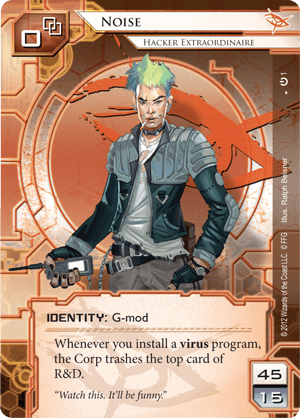
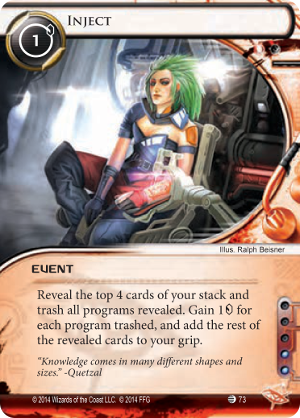
This one’s very easy to fall prey to, but it’s something I hear a lot, usually regarding Noise mills on the Corp or MaxX milling herself. The fallacy players often believe is that milling cards negatively impacts the quality of a players deck. In truth, the there’s absolutely no weighting to what cards get milled, and the distribution of cards in the deck is going to be roughly the same before and after a mill. In fact, in Netrunner, milling can helpfully inform the milled players decisions by giving them a better idea of what cards they are likely to draw in the future. This fallacy has a lot of parts to it, and there are lots of misconceptions about how milling affects deck distribution, so I want to go over them roughly in turn. It’s worth pointing out that Agendas do change this concept a bit for the Corp, but similar principles apply.
One of the main points that I want to go over is that if you take your deck and split it in half (without looking at the cards in either), you’ve got just as much chance to draw each card from either stack. Indeed, if you split a 45 card deck 45 times, and pick one of the cards, you’ve essentially just drawn a card from your deck. Removing an unseen part of your deck does not change the probability of drawing any given card from your deck. This might sound obvious to some people, but it’s definitely worth making absolutely clear. Of course, all of the milling in Netrunner (so far) allows you to see the cards you have been milled, so it’s actually a lot better for the player because they know roughly how it affects the distribution. Milling five cards from your deck is essentially the same as taking the bottom five cards from your deck, removing them, and showing them to you; in such a situation, you probably weren’t going to see them anyway, but it’s nice to know what to plan around, right? Exactly the same principle applies to true milling.
To emphasise the point above, other than the existence of Agendas and the consideration of running out of cards, milling a certain card is only bad for the player in the same situations that the card was on the bottom of your deck in a deck without milling. Basically, the absence of a milling effect affects your deck as much as shuffling, which to a well-shuffled deck is mathematically not at all. In the case when your deck “runs out”, or requires deck searching (hereafter tutor), milling can be disadvantageous, but until then, the principles above all hold. Milling can actually very beneficial for you if you have some way to retrieve from the heap. The faction with the most self-milling, Anarchs have the least deck tutors, and can rely on recursion as a functional tutor after milling some cards to the heap. They’re already the faction that finds the best use out of Clone Chip and Deja Vu because of cards like Parasite and Cache (if you’re Noise). Running out of cards can be a concern sometimes, however, especially against decks that can deal significant damage. Decks that mill themselves can well need to finish the game quickly, be ready to prevent a lot of damage, or have a Levy AR Lab Access ready to fire. The cards you’ve milled only start to become a problem when you could have drawn them if they were, instead, the very bottom cards of your deck, or you’re against a damage-based Personal Evolution deck where you need to be careful with your cards: if you’ve no cards left to draw, you can very well die as a result. I’d conjecture that with correct play, these situations happen do not come up enough for milling to be considered a major downside, but either way, they’re certainly not part of the fallacy that I’m attempting to address.
Let’s consider my above points in the case for Inject in Noise. Most people are in agreement that this card is one of the best cards for Noise ever printed, but I was extremely sceptical of it on release, so it’s kind of like a “case study” of a card that some people might reject due to this fallacy. So, as we’ve established, there’s just as much chance you get cards on the very bottom of your deck as in the bin from some mill effect. Inject essentially gives you four extra chances to ‘see’ your Cache (or other viruses), and works like a softer version of a tutor. For the purposes of ‘seeing’ cards, Inject is the best value-for-money card in the game, and can even give you 3 credits as well as mill-locating your programs. So let’s say you play Inject, and hit three copies of Cache and a Parasite. Though a naive player might curse their luck and wish they hadn’t played the card and just drawn instead, a savvy player will recognise that having cards somewhere they can easily access them with Deja Vu or Clone Chip is extremely strong, and they even gained credits for it! This isn’t meant to be a Noise guide and I’m far from the best Noise player, but hopefully it served as a good example of where milling your own cards straight into the heap is extremely beneficial!
So why are Noise’s mills so good, then? I just spent a while talking about mills in the absense of agendas, but the fact that agendas exist and are a core part of Netrunner is the reason that Noise’s ID is a strong one. The above arguments still apply somewhat. As an example, Noise won’t “mill econ” any more often than the corp will have all of their econ stacked on the bottom of their deck; what makes Noise’s mills especially potent is that he mills agendas into an easily accessible location (Archives), or otherwise makes the agenda density of R&D (and therefore cards they draw) higher compared to if the Corp hadn’t been milled, especially if they then use Jackson Howard to shuffle milled agendas back in. The reason Noise’s mills are good (other than any argument for decking the Corp) is almost purely because of agendas and their affect on the game. The mills don’t pressure your ICE suite or econ package any more than another ID, what they do is make it easier to get the Corp’s agendas, one way or another.
Alright, now on to some Mathsimum Punk Rock. I sometimes see arguments against MaxX such as “but what if she mills all of my recursion?” or similar. Now, MaxX milling recursion happens. If you’re milling your recursion, it means that when you draw, you’ve a higher chance to find the card that you actually wanted in the first place! The argument is pretty silly but it’s very easy to miss why, especially when MaxX looks at you with her two fingers up seemingly telling you where to stick it as she throws two Clone Chips in the bin. It seems to a naive onlooker that without MaxX you’d have drawn those two Clone Chips, so MaxX’s ability put the runner at a disadvantage. In fact, this example ties with the reason why MaxX’s ID ability is so damn good, and very easily one of the best ever printed: that her mills provide consistency by allowing your recursion to pull double duty as a tutor. There’s a (fallacious) argument that MaxX is high variance because of the mills, but hopefully I’ve convinced you at least somewhat at this point that MaxX’s mills are beneficial (or at the least, that they’re not negative).
At the risk of getting too off topic, let’s briefly look at some numbers and an example situation: two Anarchs (with standard 45 card decks) in a vicious race to find their Corroder! MaxX, is running the standard Reg Ass MaxX suite of two Corroder, three Clone Chip, two Deja Vu. Assuming you never draw a card apart from your ID ability, and wait for your deck to mill itself, you’ve a 98% chance to draw one of these cards. Now let’s see how Edward Kim would fare in the same scenario, with three copies of Corroder in his deck (and no Special Order or SMC or similar), trying to draw it as fast as possible. To reach 98% like MaxX, he needs to draw a whopping 32 cards. Drawing a card in MaxX also has far more impact, drawing a single card draw raises her rate to 99%, whereas Ed needs to draw two to keep pace. The “MaxX will mill/has milled all my recursion” fallacy is silly (and surely means you must have drawn some things you wanted to recur anyway). Your unfortunate mills were just as (un)likely as having breakers and/or Special Order/SMCs near the very bottom of another runner deck. The fact you can see it happening makes people think it’s some sort of unique problem with MaxX due to her ability, but in reality that’s what makes it even better for us as players because we know exactly what we won’t draw this game, and can predict what card is likely to be on top of our stack when we consider drawing cards with lower variance. The difference is that MaxX has a far higher chance to see one of the cards she needs when she draws because of the benefits of having things in your heap rather than your stack.
Randomness, Shuffling, And Card Order Fallacies
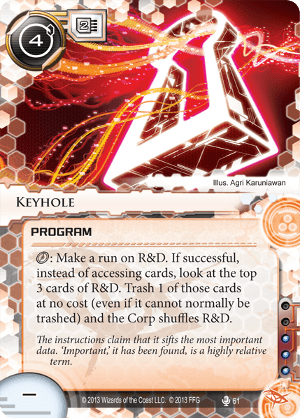
Humans are horrible at randomness. Really bad. Despite what you might think about your ability to judge how random something is, it’s probably worse still than that. Because of this, I feel like this section is really, really important, as Netrunner’s a game where randomness crops up a lot, and being a card game, shuffling is integral to how the game is played. Shuffling badly could well be viewed as cheating. I’ve heard and seen people get three of the same card in the row and declare that the deck must not have been shuffled well. In fact, if you never get cases where you draw the same cards three times in a row, that’s when you’re not shuffling well enough. A (particular) hand that contains a good distribution of cards that accurately represents the distribution of your deck is no more or less probable than a (particular) hand of five agendas.
If you want to see how well you can do at being random, I urge you to try the game provided at the following link, originally written a long time ago, in just 22 lines of an outdated programming language: http://www.loper-os.org/bad-at-entropy/manmach.html
Each time you need to shuffle in a game, you should mash shuffle (or riffle shuffle, they’re basically equivalent) your deck about 10 times. To be clear about what a mash shuffle is, it’s where you pick up half of the deck, then slide it into the other half such that there’s roughly one from the new half between each card from the old half. Numerical analysis shows that only need around 7 mash/riffle shuffles for a pretty decently randomised deck (13 is ‘almost perfect’), but that assumes you’re perfect every time, and unless you’re a casino dealer at your day job, I wouldn’t expect to have a well shuffled deck until you’ve done at least 10. Mash shuffling should be most Netrunner players’ bread and butter shuffle: this is the shuffle you should learn, use, and love. Overhand shuffling is the most well recognised shuffling technique, where you get around half of the deck, and drop amounts of cards in front of and behind the half you didn’t pick up. Overhand shuffling, along with Hindu shuffling and similar shuffles, is not sufficiently random. It has been estimated that you need about ten thousand overhand shuffles to get a fully randomised deck, which is quite a stark contrast to the 7-13 mash/riffle shuffles.
Seeding agendas or other cards in at different points in your deck (the equivalent of what’s known in Magic as “Mana Weaving”) is either pointless or cheating. If you don’t shuffle enough to have a random deck, then you’re cheating by ensuring an order about your cards. If you do shuffle enough to properly randomise your cards, then what was the point of separating cards before you shuffled? It’s important that both you and your opponents’ decks are randomised at every point they should be, otherwise you’re breaking the rules without realising it. This goes for every time a card effect or game state change requires shuffling, too. Your deck must be fully and adequately randomised.
Pile ‘shuffling’ is not shuffling and does not randomise a deck. It would be more accurately named “pile sorting”. What it does do is order the deck in a deterministic way, and with enough practice, you could very easily order your deck in such a way that it’s perfect after 3 (or any number of) pile ‘shuffles’. Pile shuffling is not a complement or replacement for proper mash shuffles and should not be treated as such. Though, this doesn’t necessarily mean you shouldn’t ever do it! Pile ‘shuffling’ can be a useful way to ensure you have the amount of cards that you’re expecting (usually 45 or 49 in Netrunner’s case), but you should recognise that what you’re doing does not randomise your deck, it just orders it in a different way than before.
If you don’t know the first thing about shuffling and are a newer player, Willingdone has an excellent video about shuffling which goes over some of the shuffles mentioned in the article. It’s a lot easier to see them in practice, and the video is fantastic if you’re unsure on how to shuffle or what any of the shuffles I’ve mentioned so far actually are:
https://www.youtube.com/watch?v=nnVABY_a6IQ
A point I made earlier but really want to completely solidify in this section is that having an agenda flood is not a sign the deck is badly randomised. Each combination of cards is just as likely as any other combination of cards in your deck (of which there are millions). I hear a surprising amount of “I mustn’t have shuffled enough” (or similar) after a bad hand gets mulliganed. It then follows that if you never get bad hands, you’re not shuffling well enough. Though this doesn’t apply to a lot of people, if you think OCTGN’s shuffling algorithm is bad, dodgy, or gives you more/less good/bad hands than in real life, you don’t shuffle enough. Swat up on how to properly shuffle a deck (mash shuffles about 10 times each time) and make sure you shuffle, and once you do that, any hand you get is because that’s what true randomness has decided you will get. Cardboard Crack, a Magic The Gathering webcomic, had a nice comic about this:
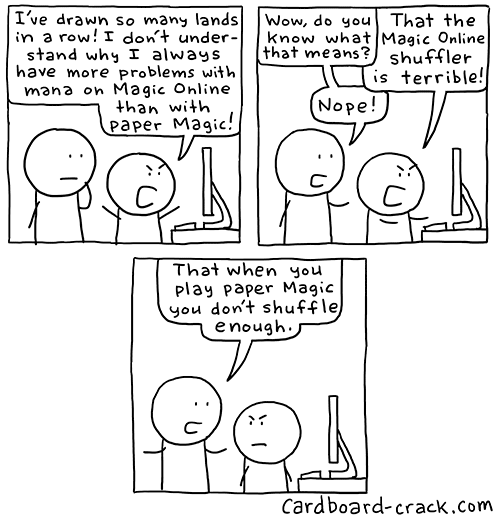
Randomness in games like these isn’t easy to intuit and it’s very easy to get lost in figures that change drastically in a real game. A (misguided) figure I hear is thrown around a lot is that it’s on average 17 accesses to win as Runner. This assumes that all agendas are worth equal points, The Future Perfect doesn’t exist, that you never have to get to 8 or 9 points to win, and ignores agenda point density. In a 49-card Corp deck with 7 (non-TFP) 5/3 agendas, the same naive maths would tell us that we instead needed 21 accesses to win, but his is still a dangerous oversimplification. Consider a game where you know an opponent has had Daily Business Show for much of the game, and you estimate their HQ is probably agendaless because of it. If (or more accurately, when) they shuffle their deck, R&D’s agenda density gets extremely high. This is just one example of the case where the figure of 17 accesses is wrong and reductionist. Netrunner isn’t just a game of numbers, and finding the best server to maximise your chance to get agendas (if indeed it’s wise to run HQ/R&D at all) is a skill. This is what makes the game so much more than seeing how many die rolls until you can get at an agenda. For an unskilled player that never runs anything but R&D whose opponent plays all 1-point agendas and no Jackson Howard, 17 accesses might be accurate, but a skilled player who adapts to the situation will appreciate that the game isn’t just a battle for R&D and that agendas can and will be elsewhere. With a significant enough choke-hold on a remote-based rush or glacier deck, the optimal line of play may just be to wait for them to try to score before running at all.
Absolutes, Or The Lack Thereof
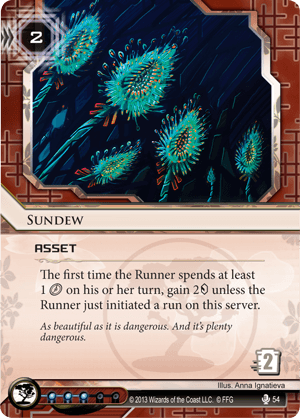
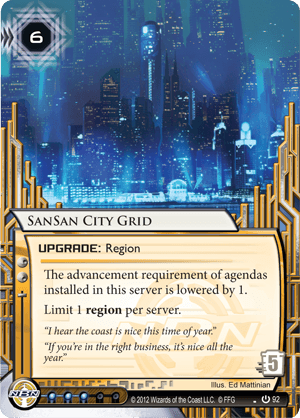
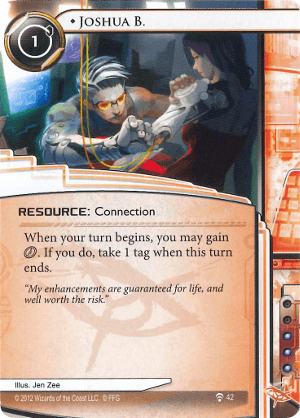
Something I hear a lot is the fallacy that one “has” to do something. I “have” to check that remote. I “have” to trash that card immediately. Hearing this is pretty common when talking about trashable, high-impact cards like Sundew, Daily Business Show or SanSan City Grid, or for the Runner, tag-me cards like Joshua B., which new players are commonly told to trash-on-sight. No. There are no absolute statements in Netrunner about lines of play unless they’re followed by an extremely long list of qualifications. Trashing these cards is very high up on a good runner’s priority list, to be clear, but then, in a game, it’s not as simple as that. Truth be told, a lot of the time these sorts of things are said in passing (or to newer players) is because it’s probably the case that they’d do better following the rule than they would on their own – though a savvy player should know that there are exceptions to the rule, and not to take it literally.
I’ll give a quick example to try and help this point along. Imagine you’re playing MaxX, and you’ve ensured a half-decent lock on R&D through the help of Medium, currently with three counters on it. Your opponent has two copies of Daily Business Show rezzed. It’s actually probably not a good idea to kill their Daily Business Shows in this situation. Again, I say probably, because there could be more factors that aren’t taken into account. Letting the DBS run gives MaxX three fresh cards on top of R&D each turn until a purge happens, and is a significant argument in favour of keeping them alive for now. There are a lot of factors to consider, including but not limited to the players relative economies and the opportunity cost of running/trashing. In short, running a taxing scoring server just to kill an unrezzed Eve is not always the best decision.
There are exceptions to basically every rule. Be extremely critical of the impact (on both the game state and economical situation) when making runs that will cost you a decent chunk of money. There are a lots of situations where any given course of action is correct, and lots of things factor into those decisions. When someone tells you “always trash X”, or something similar, what they really (should) mean is “there are more situations where you should kill X than let it live”, and regardless of how close to the truth their advice is, you should recognise that it’s meant to be (or at least, it should be) a guideline more than an unbreakable rule. It’s often wrong to open a gaping scoring window and bankrupt yourself to kill something or check a remote. The game state matters a great deal, and simple rules of thumb cannot accommodate every game state.
The Gambler’s Fallacy and the Sunk Cost/Concorde Fallacy
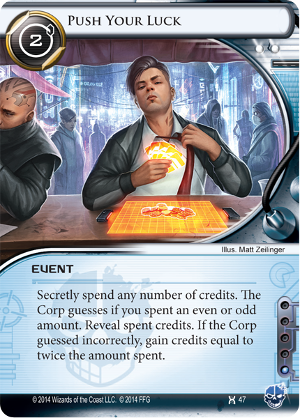
These are two more general fallacies, not specific to card games, but definitely relevant to Netrunner. They’re fallacies with names I haven’t made up for once (so you can very easily give these a search to find out more about them). You may hear a lot of talk about these fallacies in other contexts or just in general conversation. Both of these have a very high applications to poker, so if you’re looking for some more in-depth analyses on how these can affect a game, there are a lot of fantastic resources out there.
The Gambler’s Fallacy is the belief that the more times something random happens, the likelier it is that it won’t happen again in the immediate future. For example, if I were to flip 100 coins and get 100 heads, gambler’s fallacy would lead you to believe that the next coin flip is more likely to be tails. This is not the case! This isn’t the most relevant thing to Netrunner, but it’s worth mentioning. It means that despite them missing a two-in-five shot at an agenda in your hand three times, they aren’t any more likely to hit it on the fourth access.
The Sunk Cost/Concorde Fallacy is letting the fact you’ve put some resource into something irrecoverable greatly affect your decision on what to do next. An example of this would be hitting a Tollbooth and wasting money unwisely to continue down the server instead of just losing the three and jacking out. The $3 you lost shouldn’t necessarily factor into your decision of whether or not to keep going, as you will have lost it no matter what you do at that point anyway. A rational agent can indeed take sunk costs into account, but one should remain cognisant of the fallacy and indeed, not let it subconsciously control your decisions. A common example of the Sunk Cost Fallacy in Netrunner is a player not trashing drip economy assets because they’ve already been going for a few turns. Just because they’ve already got a bit from a Mental Health Clinic doesn’t mean that there aren’t situations it’s later optimal to trash it. Adonis and Eve Campaigns especially are an important case. If someone puts down an unprotected Adonis Campaign because you’re poor, but two turns later your economy stabilises, it can still be the best decision to deny them six credits for three of your own.
Escaping the Traps
It’s important to be critical about things we might take for granted. Careful analysis about everything we do during play and deckbuilding is encouraged. Next time you find yourself thinking or hear somebody saying “this card just won me a game, it must deserve its slot!”, or anything else that I covered, make sure to think more critically about what’s really being implied. It’s impossible to become a better player if you don’t think like a better player, which is why I think eliminating fallacies and errors in judgement is one of the best ways to get better at Netrunner. Furthermore, the things I said that seemed to solely relate to deckbuilding are paramount to understanding just any customizable card game at its highest level. Just as an incorrect journey will get you to an incorrect destination, incorrect reasoning will result in unsound beliefs that will only detract from quality deckbuilding and play.
If you’ve got this far, I hope you’ve enjoyed it and I hope that you can take at least something away from this article. Even if you knew all of this anyway, hopefully I gave you something else to consider that you hadn’t thought of before. Thanks for reading!




